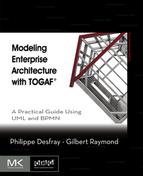Preface
Aim of this book
Today TOGAF®a is widely recognized as a standard for enterprise architecture. The TOGAF framework focuses on the architecture transformation method in all its dimensions (business, organization, and information system).
Since enterprise architecture often uses representations and models, both valuable instruments in elaboration and communication, the aim of this book is to provide a hands-on practitioner’s view of TOGAF and, notably, of the models used during transformation work.
We chose to build these models using the most widely used standards, such as UML and BPMN. Specific UML extensions (a UML profile dedicated to TOGAF) are provided in this book to further explain all necessary concepts. We have also aligned this modeling technique with ArchiMate,b which is explained in a dedicated appendix to this book.
This book does not replace the TOGAF reference specification.c Read as an initiation into or an accompaniment to the standard, it presents both the foundations of the TOGAF framework and tangible enterprise architecture elements.
We hope that this book will be a useful tool in your TOGAF-based enterprise transformation projects.
TOGAF is not the only enterprise architecture framework. Zachman, DODAF, MODAF, NAF, EAF, and even ITIL for certain aspects, all broach the subject of enterprise architecture in their own way. The number of frameworks available is probably explained by the complexity of the subject, as well as the diversity of situations encountered within different enterprises. As a consequence, TOGAF should not be considered as the “miracle cure,” but rather as a proposal capable of bringing together a number of practices around its architecture development method (ADM).
The inevitably generic nature of TOGAF can sometimes be disconcerting. However, TOGAF is generally intended to be customized in order to instantiate the method for a particular use.
Who is this book for?
From a general standpoint, this book is for anyone interested in enterprise architecture, from enterprise analysts and architects to project managers and business owners, from business managers and CIOs to students and consultants.
No prior knowledge of TOGAF is necessary before reading this book. Wherever possible, we have provided links to the corresponding chapters in the TOGAF documentation. Interested readers can refer to these chapters for more detailed information on certain points, or to consult related sections of the TOGAF documentation. References to UML and BPMN are relatively limited, and should be readily understandable to all readers who have already worked with the models.
This book is structured into two main parts:
• Part 1 (Chapters 1–4) describes the TOGAF standard and its structure, from the architecture transformation method through to governance.
• Part 2 (Chapters 5–11) presents practices and examples of enterprise architecture modeling. An example is provided for each TOGAF view, in the context of a case study.
Chapter 12 revisits three major themes of enterprise architecture: service-oriented architecture (SOA), business processes, and information. Chapter 13 presents two hands-on testimonials. Chapters 14 and 15 present ArchiMate and the EAP profile.
Acknowledgments
We would like to take this opportunity to thank Yves Caseau, Alain Delfin, Marc Garagnon, Tony Marchand, Pierre Moyen, Jim Amsden, and Joan Le Bris, as well as SOFTEAM’s entire consulting team, for their contributions and experience-based input.
